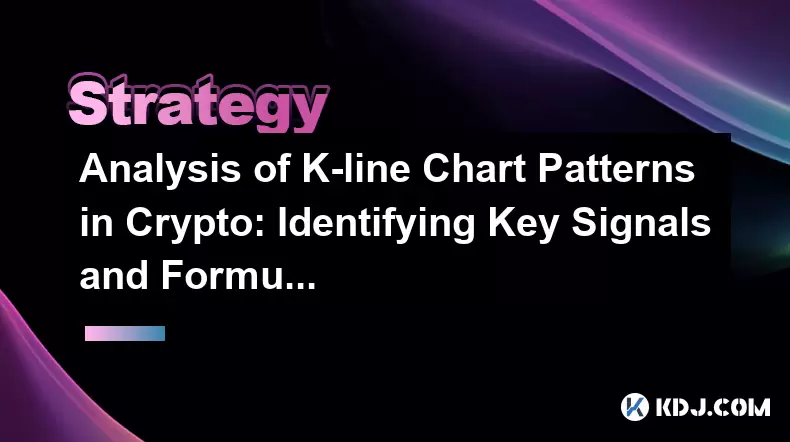-
 bitcoin
bitcoin $122090.672462 USD
1.59% -
 ethereum
ethereum $4493.758974 USD
0.56% -
 xrp
xrp $3.033145 USD
0.65% -
 tether
tether $1.000629 USD
0.00% -
 bnb
bnb $1169.854250 USD
7.07% -
 solana
solana $230.954786 USD
-0.19% -
 usd-coin
usd-coin $0.999785 USD
0.00% -
 dogecoin
dogecoin $0.256108 USD
-1.12% -
 tron
tron $0.342333 USD
-0.12% -
 cardano
cardano $0.859632 USD
-0.10% -
 hyperliquid
hyperliquid $48.932146 USD
-2.25% -
 chainlink
chainlink $22.345466 USD
-1.29% -
 ethena-usde
ethena-usde $1.000217 USD
-0.03% -
 avalanche
avalanche $31.203456 USD
1.93% -
 sui
sui $3.579145 USD
1.05%
Analysis of K-line Chart Patterns in Crypto: Identifying Key Signals and Formulating Trading Plans
K-line charts are vital in crypto trading, revealing price trends through candlestick patterns like bullish/bearish engulfing and hammer, helping traders spot reversals and optimize entry/exit points when combined with indicators like RSI or MACD.
Jun 16, 2025 at 12:56 am

Understanding the Basics of K-line Charts in Cryptocurrency
In cryptocurrency trading, K-line charts, also known as candlestick charts, are essential tools for analyzing price movements. Each K-line represents a specific time interval and shows four key data points: open, high, low, and close prices. These visual representations help traders identify market sentiment and potential reversals or continuations.
The body of the K-line indicates the range between the opening and closing prices, while the wicks or shadows show the highest and lowest prices reached during that period. A green (or white) candle means the closing price was higher than the opening price, suggesting bullish momentum. Conversely, a red (or black) candle indicates bearish pressure where the close is lower than the open.
Important Tip:
The longer the body of the candle, the stronger the buying or selling pressure during that time frame.
Common K-line Chart Patterns and Their Significance
Several recurring patterns appear on K-line charts that can offer valuable insights into possible price actions. Recognizing these formations helps traders anticipate market behavior and make informed decisions.
- Bullish Engulfing Pattern: This occurs when a small red candle is followed by a larger green candle that completely engulfs the previous one. It often signals a reversal from a downtrend to an uptrend.
- Bearish Engulfing Pattern: The opposite of the bullish pattern, this consists of a small green candle followed by a large red candle, indicating a shift from bullish to bearish sentiment.
- Hammer and Hanging Man: Both have small bodies with long lower wicks. A hammer appears at the bottom of a downtrend and suggests a potential reversal upward. The hanging man appears at the top of an uptrend and warns of a possible downturn.
- Shooting Star and Inverted Hammer: These candles have small bodies and long upper wicks. A shooting star forms at the end of an uptrend and may indicate a bearish reversal. An inverted hammer appears after a downtrend and could signal a bullish turnaround.
These patterns become more reliable when they occur at significant support or resistance levels or when confirmed by volume spikes.
How to Use K-line Patterns to Identify Entry and Exit Points
Identifying entry and exit points using K-line chart patterns requires both technical understanding and discipline. Once a valid pattern is recognized, traders should look for additional confirmation before executing trades.
For example, if a bullish engulfing pattern forms near a strong support level, a trader might consider entering a long position once the next candle closes above the high of the engulfing candle. Placing a stop-loss just below the low of the pattern helps manage risk effectively.
Conversely, in a bearish engulfing scenario near resistance, a short trade can be initiated when the following candle closes below the engulfing candle’s low. A stop-loss placed slightly above the high of the pattern ensures minimal losses if the expected move doesn’t materialize.
- Determine the pattern type and its context
- Check for confluence with support/resistance levels
- Wait for the pattern to fully form and confirm with the next candle
- Set entry, stop-loss, and take-profit levels based on pattern structure
Combining K-line Patterns with Other Technical Indicators
While K-line patterns are powerful on their own, combining them with other technical indicators increases their accuracy. Popular tools include moving averages, RSI (Relative Strength Index), and MACD (Moving Average Convergence Divergence).
Using RSI alongside candlestick patterns can help confirm overbought or oversold conditions. For instance, a hammer forming while RSI is below 30 strengthens the likelihood of a bullish reversal.
Similarly, MACD crossovers can act as confirmation signals. If a bullish engulfing pattern appears and is accompanied by a bullish MACD crossover, the probability of a successful trade increases significantly.
- Use RSI to validate overbought/oversold conditions
- Apply MACD for trend confirmation and momentum shifts
- Overlay moving averages to filter out false breakouts
This multi-indicator approach reduces the chances of acting on misleading candlestick signals.
Practical Steps for Formulating a Trading Plan Based on K-line Analysis
Creating a structured trading plan around K-line chart patterns involves several key steps. Begin by selecting a preferred time frame—day traders may focus on 15-minute or 1-hour charts, while swing traders analyze daily or weekly charts.
Next, identify high-probability patterns within those charts and assess whether they align with broader market trends. Establish clear rules for entries, exits, and risk management. Consistency is crucial—deviating from your plan based on emotions can lead to losses.
- Define your preferred time frame and market pair
- Mark key support and resistance zones
- Look for K-line patterns forming near these levels
- Set predefined entry triggers and stop-loss/take-profit levels
- Maintain a trade journal to review performance regularly
Sticking to a well-documented plan allows traders to remain objective and disciplined in volatile crypto markets.
Frequently Asked Questions
Q: Can K-line patterns be used across all cryptocurrencies?Yes, K-line patterns apply universally to all tradable assets, including Bitcoin, Ethereum, altcoins, and stablecoins. However, liquidity and volatility differences may affect pattern reliability across different coins.
Q: How accurate are K-line chart patterns in predicting price movements?No pattern guarantees 100% accuracy, but certain formations like engulfing candles and hammers have historically shown strong predictive power when combined with proper context and confirmation.
Q: Should I rely solely on K-line analysis for trading decisions?It’s generally not advisable to use any single method exclusively. Combining K-line patterns with volume analysis, trend lines, and technical indicators improves decision-making and reduces false signals.
Q: Are K-line patterns suitable for automated trading systems?Yes, many algorithmic trading strategies incorporate K-line pattern recognition. However, it's important to backtest thoroughly and account for market conditions that may impact pattern effectiveness.
Disclaimer:info@kdj.com
The information provided is not trading advice. kdj.com does not assume any responsibility for any investments made based on the information provided in this article. Cryptocurrencies are highly volatile and it is highly recommended that you invest with caution after thorough research!
If you believe that the content used on this website infringes your copyright, please contact us immediately (info@kdj.com) and we will delete it promptly.
- BlockDAG, DOGE, HYPE Sponsorship: Crypto Trends Shaping 2025
- 2025-10-01 00:25:13
- Deutsche Börse and Circle: A StableCoin Adoption Powerhouse in Europe
- 2025-10-01 00:25:13
- BlockDAG's Presale Buzz: Is It the Crypto to Watch in October 2025?
- 2025-10-01 00:30:13
- Bitcoin, Crypto, and IQ: When Genius Meets Digital Gold?
- 2025-10-01 00:30:13
- Stablecoins, American Innovation, and Wallet Tokens: The Next Frontier
- 2025-10-01 00:35:12
- NBU, Coins, and Crypto in Ukraine: A New Yorker's Take
- 2025-10-01 00:45:14
Related knowledge

Practical parameter settings for a Bitcoin multi-timeframe moving average system
Sep 18,2025 at 10:54pm
Optimizing Timeframe Combinations for Bitcoin Trading1. Selecting appropriate timeframes is crucial when building a multi-timeframe moving average sys...

How can I filter out false breakouts in Dogecoin high-frequency trading?
Sep 22,2025 at 01:00am
Understanding False Breakouts in Dogecoin Trading1. A false breakout occurs when Dogecoin's price appears to move beyond a defined support or resistan...

Techniques for identifying tops and bottoms in the Bitcoin on-chain NVT model
Sep 20,2025 at 07:54pm
Understanding the NVT Model in Bitcoin Analysis1. The Network Value to Transactions (NVT) ratio is often described as the 'P/E ratio' of the cryptocur...

What does the surge in open interest in Bitcoincoin futures mean?
Sep 20,2025 at 11:18pm
Understanding the Surge in Dogecoin Futures Open Interest1. A surge in open interest within Dogecoin futures indicates a growing number of active cont...

How can I use the Ethereum USDT premium to gauge market sentiment?
Sep 18,2025 at 11:55pm
Understanding the Ethereum USDT Premium1. The Ethereum USDT premium refers to the price difference between USDT (Tether) traded on Ethereum-based plat...

What should I do if Ethereum staking yields decline?
Sep 20,2025 at 06:18am
Understanding the Causes Behind Declining Ethereum Staking Yields1. The Ethereum network transitioned to a proof-of-stake consensus mechanism with the...

Practical parameter settings for a Bitcoin multi-timeframe moving average system
Sep 18,2025 at 10:54pm
Optimizing Timeframe Combinations for Bitcoin Trading1. Selecting appropriate timeframes is crucial when building a multi-timeframe moving average sys...

How can I filter out false breakouts in Dogecoin high-frequency trading?
Sep 22,2025 at 01:00am
Understanding False Breakouts in Dogecoin Trading1. A false breakout occurs when Dogecoin's price appears to move beyond a defined support or resistan...

Techniques for identifying tops and bottoms in the Bitcoin on-chain NVT model
Sep 20,2025 at 07:54pm
Understanding the NVT Model in Bitcoin Analysis1. The Network Value to Transactions (NVT) ratio is often described as the 'P/E ratio' of the cryptocur...

What does the surge in open interest in Bitcoincoin futures mean?
Sep 20,2025 at 11:18pm
Understanding the Surge in Dogecoin Futures Open Interest1. A surge in open interest within Dogecoin futures indicates a growing number of active cont...

How can I use the Ethereum USDT premium to gauge market sentiment?
Sep 18,2025 at 11:55pm
Understanding the Ethereum USDT Premium1. The Ethereum USDT premium refers to the price difference between USDT (Tether) traded on Ethereum-based plat...

What should I do if Ethereum staking yields decline?
Sep 20,2025 at 06:18am
Understanding the Causes Behind Declining Ethereum Staking Yields1. The Ethereum network transitioned to a proof-of-stake consensus mechanism with the...
See all articles










































































